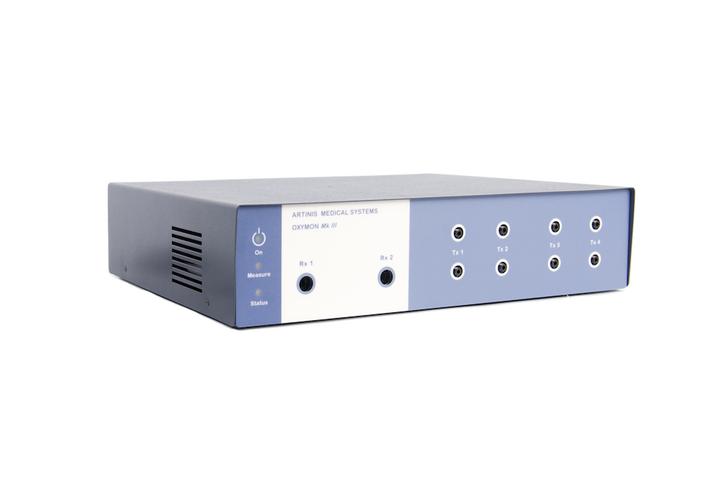
Publications using the OxyMon
Muscle and cerebral oxygenation during exercise performance after short-term respiratory work
The purpose of the study was to investigate the effect of 30-min voluntary hyperpnoea on cerebral, respiratory and leg muscle balance between O2 delivery and utilization during a subsequent constant-power test. Eight males performed a V̇O2max test, …
Algorithm construction methodology for diagnostic classification of near-infrared spectroscopy data
Background : Near-infrared spectroscopy (NIRS) has recognized potential but limited application for non-invasive diagnostic evaluation. Data analysis methodology that reproducibly distinguishes between the presence or absence of physiologic …
Attenuation of motion artifact in near infrared spectroscopy signals using a wavelet based method
The sensitivity of Near Infrared Spectroscopy (NIRS) signals to motion artifact can limit practical applications of NIRS monitoring. We describe a wavelet based method for removing motion artifact from NIRS signals. This method was tested on …
Cerebral blood flow and oxygenation at maximal exercise: The effect of clamping carbon dioxide
During exercise, as end-tidal carbon dioxide (PETCO2) drops after the respiratory compensation point (RCP), so does cerebral blood flow velocity (CBFv) and cerebral oxygenation. This low-flow, low-oxygenation state may limit work capacity. We …
Does cerebral oxygen delivery limit incremental exercise performance?
Previous studies have suggested that a reduction in cerebral oxygen delivery may limit motor drive, particularly in hypoxic conditions, where oxygen transport is impaired. We hypothesized that raising end-tidal PCO 2 (PETCO 2) during incremental …
Effects of aging on the cerebrovascular orthostatic response
When healthy subjects stand up, it is associated with a reduction in cerebral blood velocity and oxygenation although cerebral autoregulation would be considered to prevent a decrease in cerebral perfusion. Aging is associated with a higher incidence …
Frequent low-load ischemic resistance exercise to failure enhances muscle oxygen delivery and endurance capacity
This study investigated the effects of frequent low-load ischemic resistance exercise performed to failure on quadriceps size and performance, muscle activation, oxygen kinetics and cardiovascular responses. Ten healthy males performed knee-extension …
Sternocleidomastoid muscle deoxygenation in response to incremental inspiratory threshold loading measured by near infrared spectroscopy
This study investigated the pattern of changes in muscle oxygenation, deoxygenation and blood volume in the sternocleidomastoid (SCM) in comparison with the parasternal (PS) and intercostal (IC) muscles during a bout of incremental inspiratory …
Thermal effects of mobile phone RF fields on children: A provocation study
The aim of this study was to examine thermal and local blood flow responses in the head area of the preadolescent boys during exposure to radiofrequency (RF) electromagnetic fields produced by a GSM mobile phone. The design was a double-blinded …
Effects of normoxic and hypoxic exercise regimens on cardiac, muscular, and cerebral hemodynamics suppressed by severe hypoxia in humans
Hypoxic preconditioning prevents cerebrovascular/cardiovascular disorders by increasing resistance to acute ischemic stress, but severe hypoxic exposure disturbs vascular hemodynamics. This study compared how various exercise regimens with/without …
Influence of cerebral and muscle oxygenation on repeated-sprint ability
The study examined the influence of cerebral (prefrontal cortex) and muscle (vastus lateralis) oxygenation on the ability to perform repeated, cycling sprints. Thirteen team-sport athletes performed ten, 10-s sprints (with 30 s of rest) under …
Quantification of CMRO 2 without hypercapnia using simultaneous near-infrared spectroscopy and fMRI measurements
Estimation of the cerebral metabolic rate of oxygen (CMRO 2) and cerebral blood flow (CBF) is important to investigate the neurovascular coupling and physiological components in blood oxygenation level-dependent (BOLD) signals quantitatively. …
Cerebral oxygenation decreases but does not impair performance during self-paced, strenuous exercise
Aim: The reduction in cerebral oxygenation (Cox) is associated with the cessation of exercise during constant work rate and incremental tests to exhaustion. Yet in exercises of this nature, ecological validity is limited due to work rate being either …
Do radio frequencies of medical instruments common in the operating room interfere with near-infrared spectroscopy signals?
Background:Medical and diagnostic applications of near infrared spectroscopy (NIRS) areincreasing, especially in operating rooms (OR). Since NIRS is anoptical technique, radio frequency (RF) interference from other instruments isunlikely to affect …
A prior bout of contractions speeds V̇o2 and blood flow on-kinetics and reduces the V̇o2 slow-component amplitude in canine skeletal muscle contracting in situ
It was the purpose of this study to examine the effect of a priming contractile bout on oxygen, uptake (V̇o2) on-kinetics in highly oxidative skeletal muscle. Canine gastrocnemii (n = 12) were stimulated via their sciatic nerves (8 V, 0.2-ms …
Application of ultrasound dilution technology for cardiac output measurement: Cerebral and systemic hemodynamic consequences in a juvenile animal model
Objective: Analysis of cerebral and systemic hemodynamic consequences of ultrasound dilution cardiac output measurements. Design: Prospective, experimental piglet study. Setting: Animal laboratory. SUBJECTS: Nine piglets. INTERVENTIONS: Ultrasound …
Cortical oxygen supply during postural hypotension is further decreased in Alzheimer's disease, but unrelated to cholinesterase-inhibitor use
Cerebrovascular function and structure of the cortical cerebral microvessels are profoundly altered in patients with Alzheimer's disease (AD). The functional hemodynamic consequences of such changes, however, remain essentially unknown. …
Reduction of oxygenation and blood flow in pedicled bowel segments in the rat and its consequences for anastomotic healing
Purpose: Experimental studies indicate that perioperative hypoperfusion impairs anastomotic healing. In bowel surgery, the part of bowel that will be anastomosed is often pedicled, leaving the blood supply dependent on the marginal artery only. …
Resting muscle oxygen consumption by near-infrared spectroscopy in peripheral arterial disease: A parameter to be considered in a clinical setting?
Resting muscle VO2 consumption (rmVO2) as measured by near-infrared spectroscopy (NIRS) has been poorly studied in peripheral arterial disease (PAD). We studied the feasibility of its assessment in a clinical setting, compared values from PAD and …
Role of skeletal muscles impairment and brain oxygenation in limiting oxidative metabolism during exercise after bed rest
"Central" and "peripheral" limitations to oxidative metabolism during exercise were evaluated in 10 young males following a 35-day horizontal bed rest (BR). Incremental exercise (IE) and moderate- and heavy-intensity constant-load exercises (CLE) …